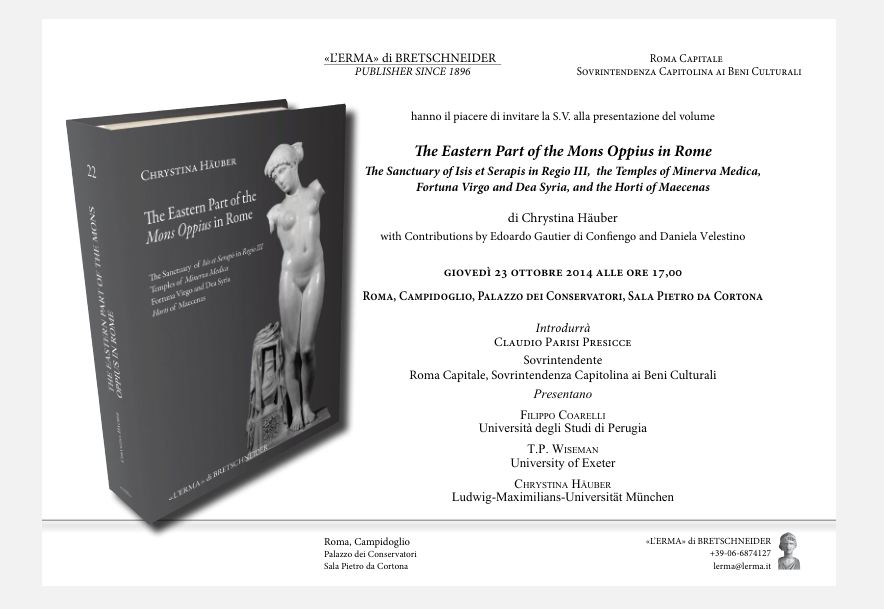
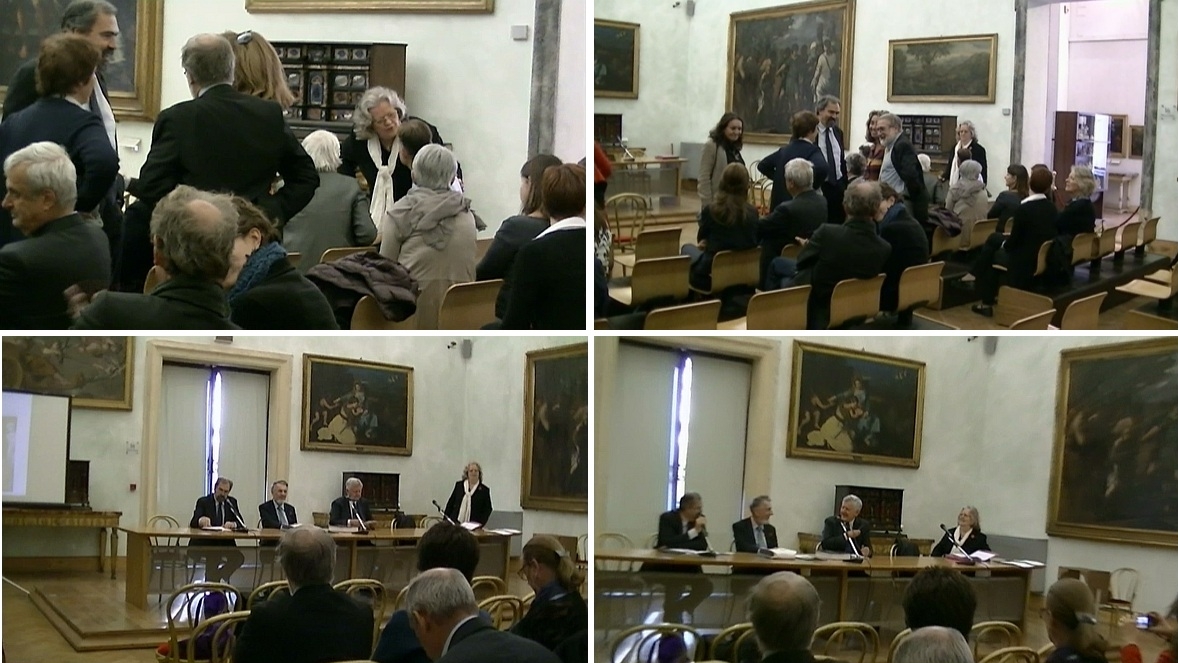
Atlantis - Greifswald - Roma
or how this book came into being
Gentili Signore e Signori, cari amici,
è un grande onore per me che oggi si presenta qui il mio libro sulla `parte est del Colle Oppio a Roma. Il santuario di Isis et Serapis in Regio III, i templi di Minerva Medica, Fortuna Virgo e Dea Syria, e gli Horti di Mecenate´. Sono anche contentissima di vedere tra di voi tanti studiosi chi hanno sostenuto i studi pubblicati in questo libro.
Devo dire che anche il fatto che possiamo rivederci in questa sala ha un valore particolare per me, perchè la esperienza inaspettata, con cui questo lavoro ha comminciato, è successo proprio in questo Palazzo davanti ad una statua antica.
Il lavoro preparatorio per questo libro ha durato tutta la mia vita professionale che (in teoria) finisce oggi con questa presentazione del libro, perchè nel mese prossimo avrò 65 anni, che (in teoria) marca la fine del mio lavoro professionale. Fortunatamente nel caso mio non sarà così, ma in futuro mi concentrerò sullo studio della topografia di Roma, invece di, come in questo libro, cercare di ricostruire anche i contesti topografici e storici di ritrovamenti archeologici di una zona della città di Roma di cui mi occupo.
Tra l'altro ho già giurato a mio marito, Franz Xaver Schütz, che sta qui con noi, di "mai più fare una cosa del genere". Ho dedicato a lui il mio libro e vedrete fra poco perchè. Lui mi ha anche chiesto di parlare in Inglese - this is why I will speak in the following in English.
Let me first of all others present here thank the "Direzione scientifica" of the `Bullettino della Commissione Archeologica Comunale di Roma´ who, on December 1st, 2011 accepted my manuscript as a supplement volume of this periodical, that is to say, Prof. Eugenio La Rocca and the Director of the Musei Capitolini, Prof. Claudio Parisi Presicce, with both of whom I had the pleasure to work since many years.
Let me secondly thank the Sovrintendente ai Beni Culturali of Roma Capitale, Prof. Claudio Parisi Presicce, for organizing together with the publishing house <<L'ERMA>> di Bretschneider this book launch in this prestigious location in the Musei Capitolini, the Sala Pietro da Cortona at the Palazzo dei Conservatori.
I also thank him for introducing today the presentations of Prof. Coarelli and Prof. Wiseman. All of them I thank for coming and for presenting my book.
Let me thirdly thank our new friends at the publishing house <<L'ERMA>> di Bretschneider in Rome to convert my modest original manuscript into a `real book´ - and my special thanks go to Giovanni Claudio Monaco - for his layout !
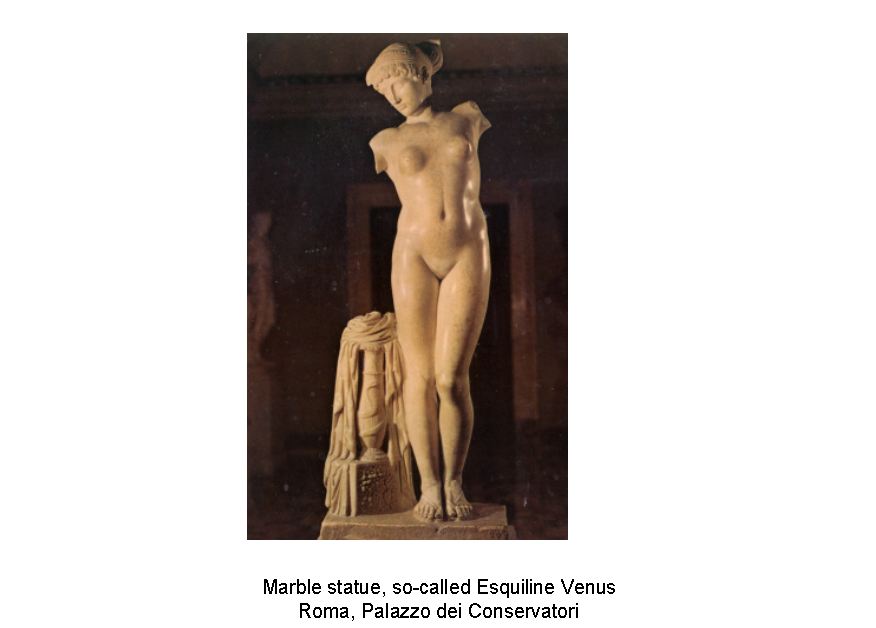
The "unexpected experience" some day in September of 1972 which was the starting point for this book, was, that I could not draw the `Esquiline Venus´, which I saw on that day for the first time at the Palazzo dei Conservatori. I could of course make a sketch in my notebook, but was unable to capture the ethos of this sculpture. This was a great shock for me because until that day I had thought a) I could draw and b) that I knew European Art History - invece no !
I was studying Art at that stage and was in Rome for the first time because I had joined a trip of the Kunstseminar/ Art Seminar Duisburg.
To explain to you why this experience was of so much importance to me, let me tell you what I had been doing until this very day in September of 1972, because it is - as I only understand now - the education that I had experienced before I started as "Zweitstudium"/ second major Classical Archaeology, WHY I am conducting my research that is summarized in my book, and especially HOW I do certain things.
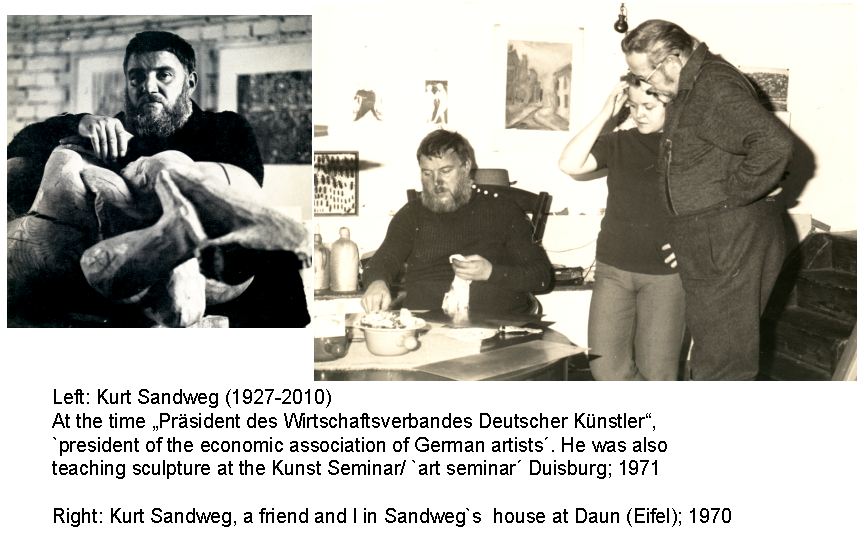
Kurt Sandweg was from 1969-1972 my teacher in Sculpture at the Kunstseminar/ Art Seminar Duisburg. I happened to be his first student and he employed me as his assistant. In his home at Düsseldorf he had an important art collection; he also knew many art collectors and art dealers whom I met there. Kurt Sandweg was an extremely generous man: he traveled with me to all big exhibitions and museums in Europe and in England because he thought I should know these things. And because of the character of my own sculptures, Sandweg suggested to me that I should - as an artist - study Roman art.
In the summer of 1971, Kurt Sandweg went with some of his students including me to see the "Genter Altar"/ the altarpiece painted by the brothers van Eyck in the Church of St. Bavo at Gent/ Gand in Belgium -
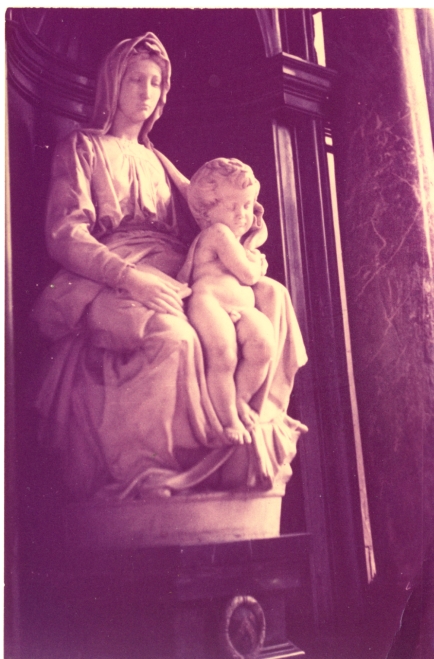
- where we also saw the marble group by Michelangelo Buonarroti shown here. Seeing that child, Sandweg and I were so deeply impressed that we decided to go to Rome to see more of Michelangelos famous works and started immediately to prepare ourselves for that trip.
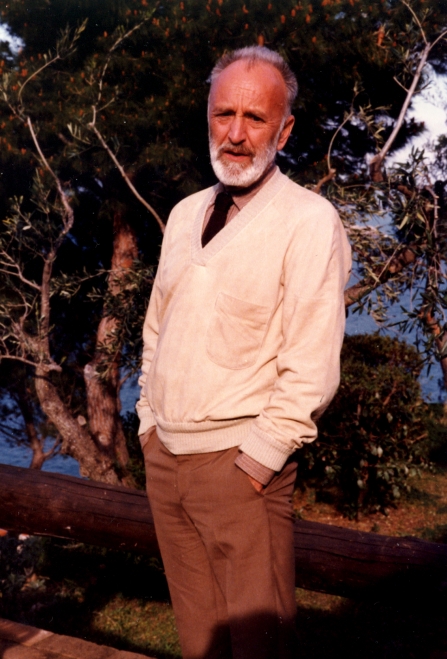
The Director of the Art Seminar Duisburg, the painter Wilhelm Menning had a very different plan with me, he did everything to convince me that yes, of course, I should study Art History and Archaeology as an artist, but that I should also become a scholar in these fields. When I had seen the `Esquiline Venus´ in September of 1972 during our trip to Rome with the Art Seminar that he had directed, Menning had won - and I am very thankful for that.
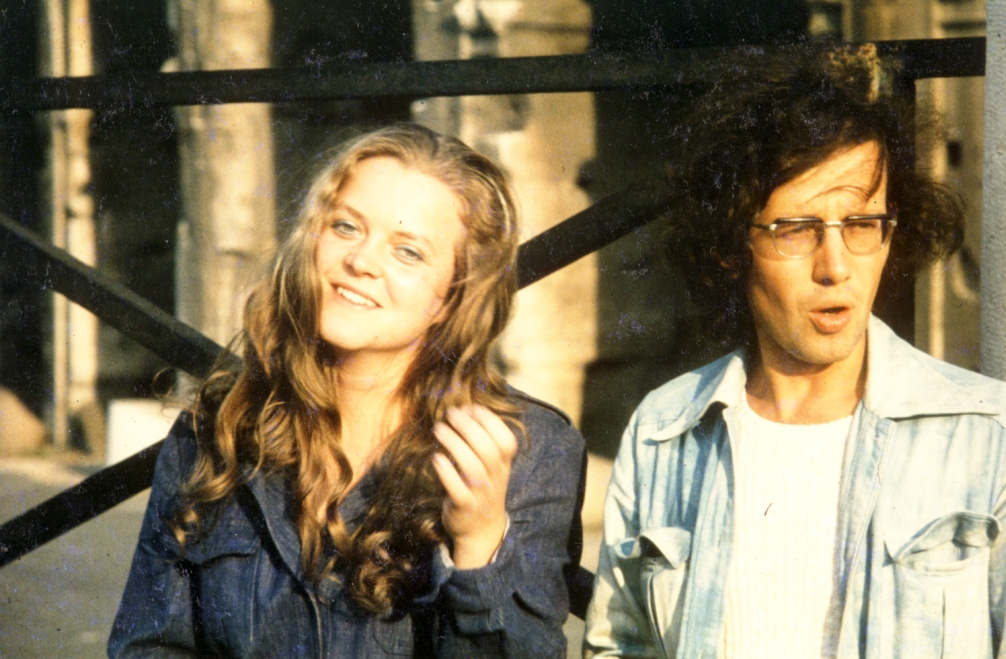
Martin Goppelsröder was at the Art Seminar Duisburg my teacher in drawing. You see me here still self-assured at a point when I had not yet seen the `Esquiline Venus´.
After seeing the `Esquiline Venus´, I was very sad and wandered down the Cordonata of the Campidoglio hanging my head, since I knew that one or two months later I would pass my last exams, and because I was wondering how I could finance after those State Exams in Art a "Zweitstudium"/ a second major, that is to say, in Classical Archaeology and Art History. Already since October 1969 I had been financing my studies myself.
When back from the Rome trip of 1972, I told my parents - both of whom and their new partners were, as expected, very much against my idea to study as second major Classical Archaeology.

Another teacher at the Art Seminar Duisburg, the Classical Archaeologist Katja Marina (Karina) Türr, who had organized our Rome trip of September 1972, kept likewise urging me to study Classical Archaeology and Art History as second major. She had studied at the University of Cologne with the famous Classical Archaeologist Heinz Kähler, and suggested to me to study likewise with Kähler.
Karina Türr introduced me to Hansgeorg Oehler, the Director of the photographic archive "Monumenta Artis Romanae" at the Institute of Archaeology of Cologne University, with the result that Oehler employed me as "Studentische Hilfskraft" in July of 1973 - and I could thus indeed begin to study at this University.
Besides, Oehler could only employ me as a Studentische Hilfskraft, because I had already passed a State Exam (November 1972); I had started studying at the Werkkunstschule Krefeld in the Wintersemester of 1968/69 (Graphik, Zeichnen, Design), and since the Wintersemester of 1969/70 at the University/ Gesamthochschule Duisburg (Kunst, Theologie, Geographie).
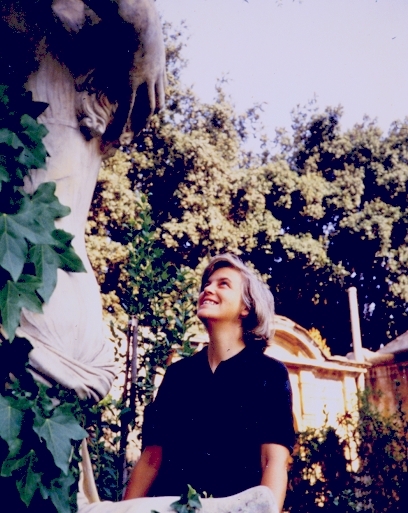
On the very first day that I was employed at his photographic archive "Monumenta Artis Romanae", Hansgeorg Oehler received friends whom he knew from England and introduced me to them: Prof. Brian Shefton and Amanda Claridge, who is likewise fortunately here with us this afternoon.
At that stage, Amanda was on her way back home from Rome, where she had just had a scholarship at the British School at Rome. Amanda was from the very first day we met interested in my work - and of course I in hers, which is why I visited her afterwards several times in London, where she lived at that stage. We should `by chance´ meet again in Rome on December 30th, 1980, when she was Assistant Director of the British School at Rome. On that day she invited me to use the famous Library there. - It was this fact that should enable me to write my book. But let me tell you the whole story in chronological order.
In 1974 died the Professor of Classical Archaeology of the University of Cologne, Heinz Kähler, the famous Romanist, whose lecture courses were legendary; cf. Ernst Künzl (2004).
Luckily, I had been able to attend Kähler's very last lecture course in the Wintersemester of 1972/ 73 (as a guest, since I did not as yet study at Cologne); see for that last lecture course of Kähler now Häuber (2021/2023, pp. 731-733). At the University of Cologne, I should also study with the Art Historian Prof. Heinz Ladendorf who was of equal prominence.
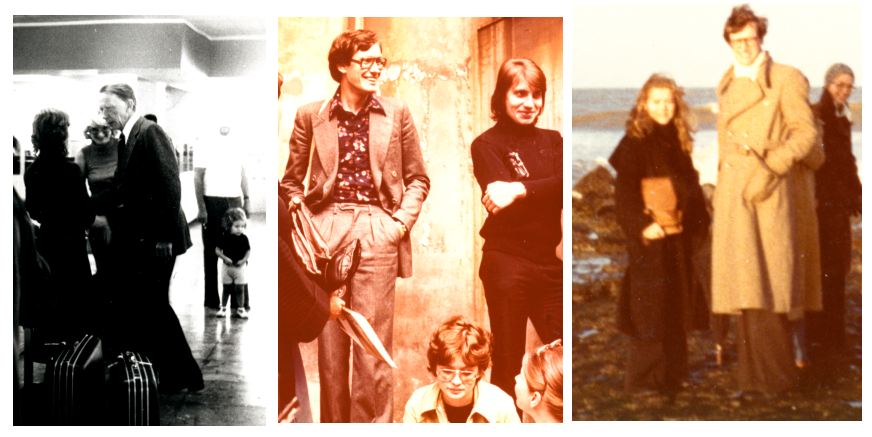
Heinz Ladendorf was an expert in the scholarly field "das Nachleben der Antike" (`the reception of antiquity´; `la tradizione classica nella cultura moderna´).
Ladendorf was also known for the `impossible´, because gigantic subjects that he suggested to his students as their dissertation projects. People who knew Ladendorf called these dissertations "Materialschlachten", literally: battles of material, a German expression for the new kind of warfare that had been invented in World War I.
One of his phd-students who had `survived´ such a dissertation was his Assistant Professor Dirk Kocks. He was not only a scholar, but owned also a huge art collection and was a successful painter.
When I started studying Art History with Dirk Kocks in the Sommersemester of 1974, he was writing his "Habilitationsschrift". After this seminar, he went with us in the summer of 1974 to Belgium to see the medieval paintings that we had been studying with him.
Dirk Kocks told me on the day when this photograph was taken, that he was studying for his Habilitationsschrift 300.000 drawings by the French artist Jean-Baptiste Carpeaux, and offered me to employ me to help him with this project, for example by writing texts.
He said that he was especially interested in employing me for this task, assuming that I had some experience with artists, who had worked in Rome. He showed me a photocopy of one of those drawings: people looking out of the windows of a -"Pferdebahn"? (a predecessor of our buses). I actually happened to know, that these figures were copied after Raphael's painting "Fischzug Petri" in the Vatican Palaces.
When I replied that I could not possibly do this, Kocks said: "Papperlapapp", adding to this: if I wanted to become a scholar, I would anyway have to write texts. I therefore agreed and as a result of this, we became for the following years until his death the ideal working team.
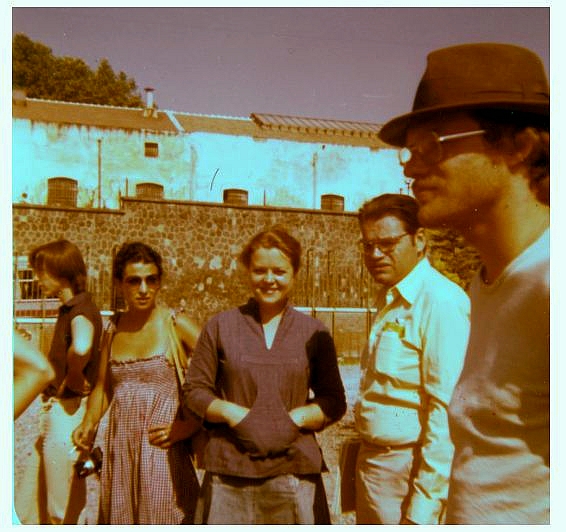
The gentleman in the white shirt is Andreas Linfert, the young man in the foreground on the right some of you certainly know much better than me: Dr. Michael Jung, now Curatore del settore islamico at the Museo Nazionale d'Arte Orientale at the Palazzo Brancaccio in Rome, who is fortunately likewise with us today.
When I first met Andreas Linfert in 1972, he was Assistant Professor of Heinz Kähler in the Institute of Classical Archaeology at the University of Cologne.
Linfert was an expert in ancient Greek sculpture and a fascinating teacher. Like Dirk Kocks, Andreas Linfert was a very generous man, and became likewise a close friend. After my presentation in one of Andreas Linfert's seminars (1975) of the portraits of the Ptolemaic queens, especially of Cleopatra VII, I asked him, whether he would accept me as his phd-student. He did. I was again, as earlier with Kurt Sandweg, his first phd-student and Linfert acted similarly. He had the largest library I have ever seen in a private home and he knew his books: from now on he `bombarded´ me with his vast knowledge of (ancient) Greek culture.
Andreas Linfert thought that dissertations are "Kinderkrankheiten" (`children's illnesses´), that is to say, relatively short affairs. In retrospect, I understand now the reason for that: he had been a member of a `school´. He himself educated me very differently; only two years ago, by discussing the matter with several friends at the British School at Rome, I understood what Dirk Kocks for Art History and Andreas Linfert for Classical Archaeology had actually done when teaching me their fields. At Oxford this is called a `one-to-one tutorship´ meaning: one professor for one student.
Since I had studied Art before, when Kurt Sandweg had chosen me as his first student after my successful so-called "Mappenvorlage" (an exam, that consisted in his critical discussion of my drawings that I had brought with me), I thought that was normal. But at a German University that was anything but normal at that time. The difference between those two ways of teaching is the following: Andreas Linfert thought I would write my dissertation in 2-3 years: in such a case the student receives a subject from his or her supervisor, and does something totally different after the dissertation. Whereas I myself, having first been trained as an artist, and then by the Art Historians Heinz Ladendorf and Dirk Kocks, act differently: the subject has ME and it keeps me busy for my whole life.
Andreas Linfert became the reason that I met all of you who are present here this afternoon. And I am VERY grateful for that.
The reason was that Linfert wanted ME to find my dissertation subject myself - a task that I was unable to fulfil, of course. When this photograph was taken in 1978, I was studying the sculptural finds from the Villa of the Papyri/ Villa dei Papiri at Herculaneum that are kept in the Museo Archeologico Nazionale at Naples. The following year (1979) I should meet Mario Torelli in Naples - who unfortunately cannot be with us this afternoon; cf. for Torelli now Häuber (2021/2023, pp. 3, 7-9, 1343-1349). Mario Torelli told me that (again) I should also abandon this subject, because a student of the University of Perugia had already earlier started to study this topic as her phd-project. Thanks to Mario Torelli's support, I finally came in October of 1980 to Rome, with a scholarship of the German Academic Exchange Service, to study at the famous Library of the Deutsches Archäologisches Institut Rom, the `Germanico´.
At that stage, I was working on a new subject, the statues from the Villa of Chirargan in southern France which are on display in a Museum at Toulouse. I thus prepared myself for a visit there, and made an appointment for Monday 2nd of March 1981, by writing ahead of time a letter to the Director of this Museum.
When there, the Director told me that she had never received my letter and offered me to look at those statues on that very day - the following day all the sculptures would be packed because the museum would be restored for five years. She also told me that she would never have considered to allow me to write my dissertation on those sculptures - in case she had received my letter at all.
After that blow I called Andreas Linfert and he agreed that I could pursue a subject that I had already started in 1978 and later abandoned, the sculptural finds from the Horti Sallustiani in Rome (to this I will come back below). A couple of days later I was back in the Library of the British School at Rome and on March 19th 1981, one of the assistant librarians, Demetrios Michaelides, addressed me and asked me why I was studying the Horti Sallustiani.

Four days later I went again down the Cordonata of the Campidoglio - but this time singing - so that a very old Roman, who had been watching me, asked me what had happened.
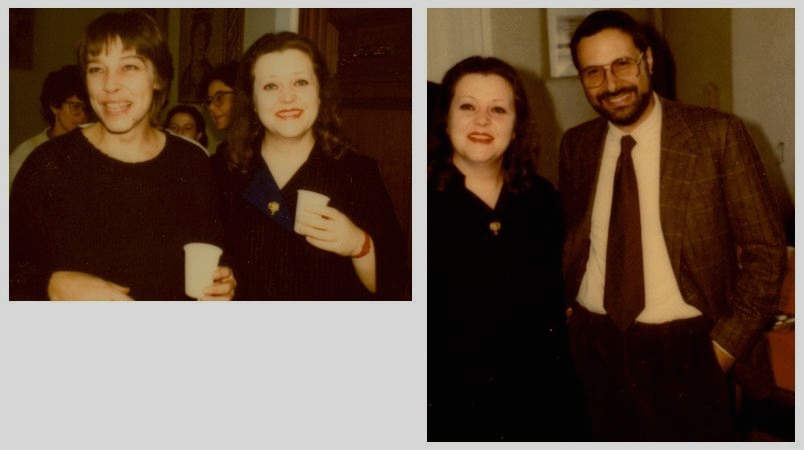
What had happened that made me so cheerful on the morning of March 23rd 1981?
Demetrios Michaelides had suggested to me to ask Eugenio La Rocca, if I could study the sculptural finds from the Horti of Maecenas. La Rocca had just offered this subject to him, but because Demetrios planned to go back to Cyprus at that stage, he mentioned Eugenio La Rocca's offer to me. As suggested by Demetrios, I had met Eugenio La Rocca the following day at a conference held at the American Academy in Rome (on March 20th). Mario Torelli, who `happened´ to be there as well, had introduced me to him, and La Rocca had invited me to see him on Monday, 23rd of March in his office at the Musei Capitolini.
At that meeting, Eugenio La Rocca kindly agreed that I could study those sculptures, but before I would need to study ALL the sculptural finds `excavated´ in the period Roma Capitale after 1870 (especially those found on the Esquiline), in order to be able to identify those sculptures that had occurred within the Horti of Maecenas.
Eugenio La Rocca told me that morning that I could immediately start with this project, and introduced me to everyone in the Musei Capitolini. La Rocca showed me also the tesi di laurea, written by Laura Cianfriglia on the Horti of Maecenas, whom I met shortly afterwards, and who is fortunately likewise with us this afternoon.
As a matter of fact, I had never before been received so kindly in an institution as by Eugenio La Rocca that day. Because I thus became a "freie Mitarbeiterin" of Eugenio La Rocca, he has given me nothing less than a "Zuhause" (a `home´) at the Musei Capitolini, and after the nightmare that had lasted from 1975-1981, during which I had in vain been searching a dissertation project, I was the happiest person in the world.
What followed were the fruitful research years from 1981-1985 at the Musei Capitolini, where I had the chance to work, greatly supported by Eugenio La Rocca, on my own dissertation project, the Horti of Maecenas, and, in addition to this, since November 22nd of 1982, together with La Rocca and his team, who was conducting research for his exhibition on the Horti Lamiani; cf. Maddalena Cima and Eugenio La Rocca (1986); Häuber (1986).
Among those, with whom I had the chance to work in those years at the Musei Capitolini, of whom some are here with us today, were Maddalena (Magda) Cima, Emilia Talamo, Lina Bonofiglio, Marina Bertoletti, Marina Wappner and Marina Mattei - the "tre Marine" of the "ufficio delle tre Marine", Margherita Albertoni, Laura Ferrea and Anna Mura Sommella.
As already mentioned above, much of my relevant research was conducted since the 30th December of 1980 in the Library of the British School at Rome, where the Librarians Luciana Valentini, Demetrios Michaelides and later Anthony Alcock, Valerie Scott, Beatrice Gelosia and Fancesca Deli greatly supported my research, and where Lucos Cozza, Nicholas Purcell and T.P. Wiseman taught me how to study the topography of (ancient) Rome; see all my relevant publications since 1983.
In the following, I will mention some of the results of this research, presented in my book.

According to the hypothesis, published in my book the female represented in the `Esquiline Venus´ may not be identified as Venus but rather as a mortal girl, and precisely as a Greek bride, who is shown at her marriage preparations. The resulting consequences are complex and comprise a large section of my book. I suggest that not only the `Esquiline Venus´, but also all the other sculptures found together with her in a secondary context, for example the likewise famous marble bust of Commodus as Hercules Romanus, and the two statues of `Muses´, were originally dedicated in the sanctuary of Isis et Serapis in Regio III in Rome.
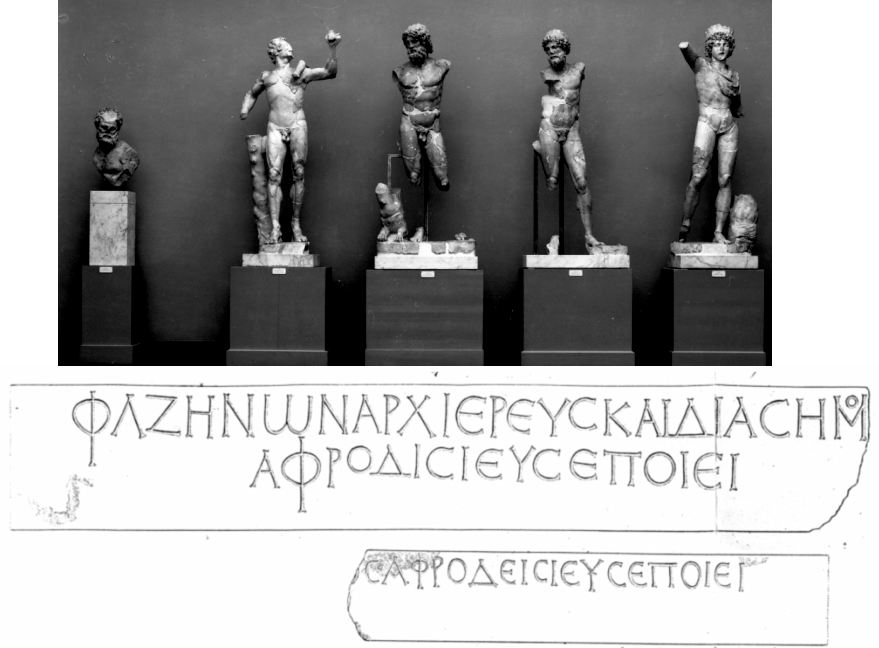
Another hypothesis that I suggest in my book is that the famous `Esquiline Group´, found on the Oppian, was likewise originally dedicated in the sanctuary of Isis et Serapis in Regio III.
Because I found `new´ evidence concerning the two inscriptions shown on the slide that belong to this group of statues, I re-date those sculptures to the Severan period. The inscriptions were found in a collapsed building on top of which in late antiquity the well-known private baths on Via Ariosto had been erected.
I am, therefore, very glad that Magda Cima is here with us today, who has studied those baths and the archaeological finds excavated there, as well as Salvo Barrano, Mariateresa Martines and Liliana Guspini, who have recently excavated the domus to which those baths had probably belonged.
Other findings that are discussed in my book in detail are those related to the cult-statues from the sanctuary Isis et Serapis in Regio III on the Mons Oppius; these functions had so far not been attributed to the sculptures in question.
And after preliminary studies of the possible findspot of the Laocoon group; cf. Häuber and Schütz (2004) and Häuber (2006; and 2009), I have in this book concentrated on this problem in depth. In my opinion, the area in question belonged to the Horti of Maecenas. I have also discussed the consequences which this assumption may have had for the possible meaning of this sculpture. - To both subjects I will come back below.
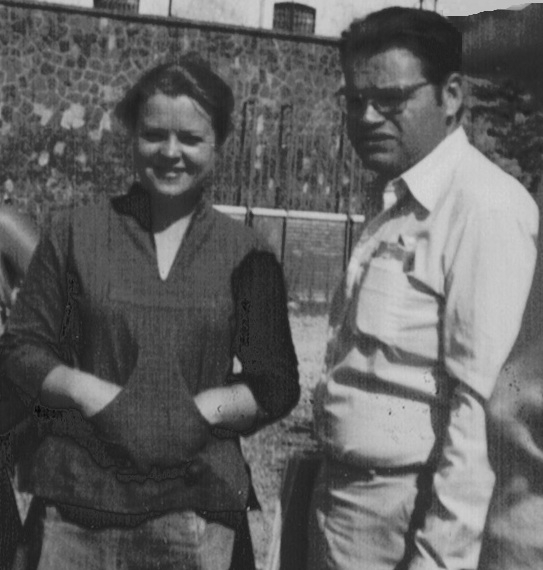
The subject for my dissertation that Andreas Linfert and I had agreed upon was called "Schriftquellen und Denkmäler", `literary sources and archaeological finds´, to be tested by discussing a group of ancient sculptures, of which the person was known who had commissioned them. Linfert hoped the relevant research would result in a contribution to the "Kunstgeschmack" `taste´ of the relevant time. As already mentioned, to find an appropriate group of sculptures had kept me busy for six years (1975-1981); but the steps that followed after that proved to be no less time consuming.
The first two epigraphs of the chapter on the methodology applied in my book (on p. 1), written by T.P. Wiseman, actually sound very similar like "Schriftquellen und Denkmäler", `literary sources and archaeological finds´, but as a matter of fact, it is now meant very differently.
The reason being that Andreas Linfert and I were not familiar with the problems that I only came across when actually working in Rome:
1.) the findspots of the sculptures commonly attributed to the Horti of Maecenas were in reality in many cases unknown, 2.) the ancient topography of the area in question was by no means clear, and 3.) there were no accurate maps of the area, in which all the toponyms discussed in the relevant scholarly debate were marked.
It took me until 1986 to finish my thesis, in which I established the findspots of the sculptures found in my research area. The interpretation of those finds, as wished by Linfert, was nevertheless still impossible. As the next step I therefore studied the topography of the relevant area in depth - to this topic I will come back in a minute. My resulting first topographical study was published in 1990. This had the unforeseen effect, that I had now to rewrite my entire thesis again. This second version of my thesis was published in 1991. But that was still not what Andreas Linfert and I had hoped to achieve. In the "Vorwort" (`preface´) of my dissertation (1991, p. 5), I wrote therefore with Andreas Linfert's consent:

My book offers now this `detailed discussion of (at least some of) the complexes of sculptures´ found in this area, as well as a discussion of the ancient topography. In addition to this the book contains on a CD-ROM maps in which the toponyms discussed in the text are marked; the relevant research had kept me busy for another 23 years (1991-2014).
None of these three large research topics (the discussion of archaeological finds that had occurred in my research area, the discussion of the topography of this area, nor the drawing of the relevant maps) I could possibly handle alone.
To start with the topography:
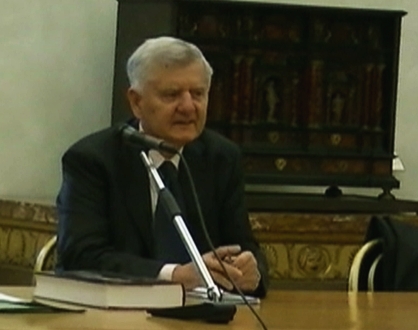
When I came to Rome in October of 1980 in order to write my thesis, I didn't have the foggiest idea concerning the research area `topography of ancient Rome´. The only scholar I knew as being an expert in this field was Filippo Coarelli. And although Andreas Linfert had admonished me, not to molest anyone with questions when I would enjoy the privilege of working in the famous library of the Deutsches Archäologisches Institut Rom, I actually did this in the end. Thinking it would be a good idea to translate Coarelli's "Guida di Roma" of 1980 `from cover to cover´ to get a vague idea where I was, I quickly ran into some problems because I was unable to understand some of his remarks related to the topography. So some day in late 1980, I approached Filippo Coarelli, asking him in my grezzo Italiano the 10 questions I had - and to my great surprise he did not laugh at me but explained to me very patiently what I had been unable to understand. Coarelli was also kind enough to support from the very beginning the studies that are published in my book (for a discussion see on p. XVI).
[Up to this point I could read on 23rd October 2014 a drastically shortened version of this text that was 3 pages long]
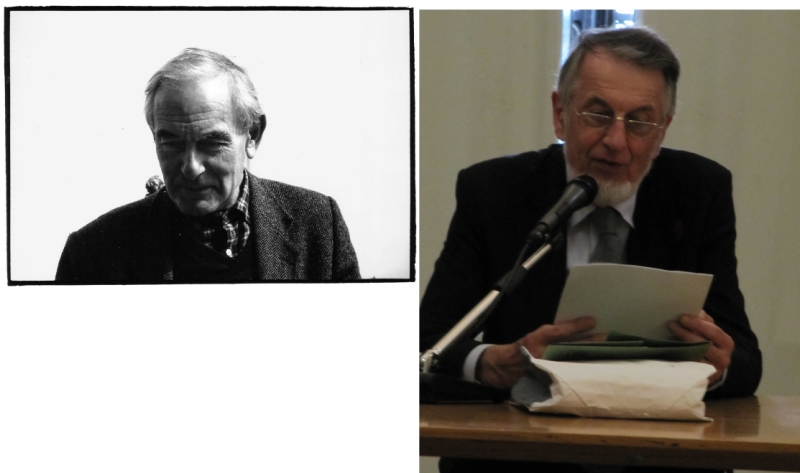
This slide shows you the late Prof. Lucos Cozza on the left, the famous expert of the topography of ancient Rome, and on the right another expert in this field, the classicist and ancient historian Prof. T.P. Wiseman, who has just spoken to us.
It is thanks to those two scholars that I finally realized that the solution to my scholarly problems was and is the study of the topography of (ancient) Rome. I cannot express the gratitude that I feel for both of these scholars that they have actually taken the time to teach me the relevant methodology.
Not by chance have I met both of them in the Library of the British School at Rome: Lucos Cozza in January 1981; cf. Häuber (2015), and T.P. Wiseman in January 1984. See in detail for the importance of both scholars for my research, in this book on p. XXI; and for Peter Wiseman's support of this book, on pp. XXVII-XXVIII.
Because, when Andreas Linfert and I discussed my dissertation project "Schriftquellen und Denkmäler", both of us had completely ignored the following facts. Since I wanted to discuss such a complex of ancient statues that were found in Rome, I needed to discuss in the first place the history and topography of the relevant area, and that diachronically over time.
And when it comes to the last great problem that I could not solve on my own: create maps of Rome, in which all the toponyms that I mention in my book, are marked, it was my husband, the geographer and computer specialist Franz Xaver Schütz, who, since we worked together in an excavation at Greifswald in 1994 has taught me the relevant methodology.
Atlantis - Greifswald - Roma
or how this book came into being
How on earth did I end up in 1994 in Greifswald?
In 1992, I was appointed at the `Museum für Holographie´ in Pulheim. The owner, Matthias Lauk, owned at that time also a company ("Lauk Kommunikation GmbH") and won, together with his team, a competition: we were elected to reconstruct the mythical Atlantis. Because I did not want to reconstruct Atlantis, but rather Rome, I left this team.
Being unable to raise money for such a large Rome project, I consulted a soothsayer, who, to attain this goal, suggested to me to change my name according to the rules of numerology. I, therefore, changed my name from `Ruth Christine´ into `Chrystina´.
Shortly after that Amanda Claridge invited me to give a talk at the British School at Rome on my recent research ("Isis et Serapis regio III: the Esquiline Iseum", 26th November 1992) - with the manuscript of this talk my book has actually been started.
After that, and likewise unforeseen, I was invited to direct excavations, first in Rostock (1993), then in Greifswald (1994).
The following discussion has happened in August of 1994 at this excavation in Greifswald.
Making notes in my "Grabungstagebuch" (the diary of this excavation), I said to myself:
"Ich möchte die Landschaft rekonstruieren [i.e., the area of my excavation]";
Franz Xaver Schütz (who stood beside me) said: "Nimm doch ein GIS";
I asked him: "Was ist denn das, eine neue Zahnpasta ?";
Franz: "Nein ...".
(I: `I would like to reconstruct the landscape´;
Franz: `Why don't you apply a GIS ?´;
I: `What's that, a new toothpaste?´;
Franz: `No ...´).
This is how our project FORTVNA was started in August of 1994 in the city of Greifswald, the results of which are published in my book.
The reason being that we chose as the research area, in which we wanted to test our methodology, `the eastern part of the Mons Oppius in Rome´.
On 8th August 1994, I met Franz Xaver Schütz in my excavation at Greifswald. Franz and I decided to collaborate together in trying to reconstruct the landscape and the topography of ancient Rome by drawing relevant maps. At first we developed for this purpose the Software called FORTVNA, then, on the basis of this, the Archaeological Information System "AIS ROMA", on the basis of which all our Rome maps are drawn.
To conclude. I thank all the above-mentioned friends and colleagues for their patience with me throughout the many years that I have needed to write my book, but especially so my best friend and husband, Franz Xaver Schütz. Last but not least I thank Roberto Marcucci, Elena Montani and all their collaborators of their publishing house <<L'ERMA>> di Bretschneider, because my book which they have printed, has already changed my life !
Nachträge
Ich danke meiner inzwischen verstorbenen Freundin Amanda Claridge, die freundlicherweise das Englisch meines Vortragstitels korrigiert hatte, sowie Eberhard Thomas für Auskünfte zu einigen auf den hier gezeigten Photos sichtbaren Personen, die im fraglichen Zeitraum, ebenso wie er selbst und ich, im Archäologischen Institut der Universität zu Köln tätig waren.
Diesen Vortrag wollte ich bei der Vorstellung meines Buches "The Eastern Part of the Mons Oppius in Rome" (2014) am 23. Oktober 2014 in der "Sala Pietro da Cortona" im Konservatorenpalast in Rom halten. Das war leider nur zum Teil möglich, weil ich nicht hatte kommen sehen, dass die Programmpunkte vor meiner Rede mehr Zeit in Anspruch nehmen würden als erwartet. Problematisch war das im Übrigen nur deshalb, weil mein Mann und ich die Besucher der Buchvorstellung danach zu einem Empfang einladen wollten. Diesen Empfang hatte das Restaurant "Terrazza Caffarelli" vorbereitet, das sich unmittelbar neben der "Sala Pietro da Cortona" befindet. Als uns eine Stunde nach Ablauf des ursprünglichen Zeitplans die Betreiberin des Restaurants "Terrazza Caffarelli" signalisierte, dass der Beginn des anschließenden Empfangs nicht noch weiter hinausgezögert werden könne, habe ich deshalb nur einen drastisch gekürzten Teil meines Textes vorgelesen. Der hier publizierte Text ist die (erweiterte) Fassung meines originalen Manuskripts vom 23. Oktober 2014.
Chrystina Häuber, München 11. April 2024
Wenn nicht anders angegeben, dann befinden sich die abgebildeten Photos in meinem Besitz.
Die in diesem Vortragstext zitierte Literatur aus meinem Buch (2014) ist auf unserem Webserver unter folgendem Link zu finden:
https://fortvna-research.org/texte/HAEUBER_2014_Bibliography.html
Meine Dissertation (1991), die meinem Buch (2014) zu Grunde liegt, ist auf unserem Webserver unter folgendem Link publiziert:
https://fortvna-research.org/texte/haeuber_1991.html
Zusätzlich habe ich in dem hier publizierten Vortragstext noch auf folgende Publikationen hingewiesen:
Ernst Künzl 2004, "Heinz Kähler als Archäologe und akademischer Lehrer zu seinem 100. Geburtstag am 21. Januar 2005", KölnJb 37 (2004) 907-920.
Chrystina Häuber 2015, Rome: the city of memories. Or, why and how reconstruct and visualize ancient and post-antique Rome using digital technologies? The "AIS ROMA", diachronic and phase maps of (ancient) Rome in the WWW, Long version 2015, München. The International Symposium Reconstruction and the Historic City: Rome and Abroad an interdisciplinary approach, 17.-19. Oktober 2012, LMU München, Deutschland, pp. 1-62. Online: https://doi.org/10.5282/ubm/epub.24136
Andrew Wallace-Hadrill 2001, THE BRITISH SCHOOL AT ROME One Hundred Years (The British School at Rome 2001).
Apropos, mein 1978 begonnenes, aber wieder aufgegebenes Dissertationsthema `die Statuen aus den Horti Sallustiani in Rom´, das ich im März 1981 zunächst hatte weiter bearbeiten wollen. Siehe zu den mit diesem Thema verbundenen Problemen: Häuber, The Cancelleria Reliefs and Domitian's Obelisk in Rome in context of the legitimation of Domitian's reign... In Honour of Rose Mary Sheldon, FORTVNA PAPERS III-1 (2021/2023), S. 593-597.
Auch nach der Publikation meines Buches (2014), habe ich mich weiterhin mit den Kultstatuen des Heiligtums Isis et Serapis der Regio III beschäftigt. Siehe den folgenden Text: Franz Xaver Schütz und Chrystina Häuber 2020, "The fragmentary cult-statues of the sanctuary Isis et Serapis in Regio III / Die fragmentarischen Kultstatuen des Heiligtums Isis et Serapis der Regio III", der auf unserem Webserver publiziert ist. Siehe:
https://fortvna-research.org/texte/Kultstatuen_Heiligtum_Isis_et_Serapis_Regio_3_Rom.html
Auch die Laokoongruppe hat mich nach meinem Buch (2014) noch weiterhin beschäftigt.
Siehe Chrystina Häuber, FORTVNA PAPERS vol. IV (in Vorbereitung), Die Laokoongruppe im Vatikan - drei Männer und zwei Schlangen: `Ich weiß gar nicht, warum die sich so aufregen´ (Wolfgang Böhme) - die Bestätigung von F. Magis Restaurierung der Gruppe und der Behauptungen, sie sei für die Horti des Maecenas, später Domus Titi, geschaffen, und dort entdeckt worden. Siehe die Vorschau auf unserem Webserver:
https://fortvna-research.org/FORTVNA/FP4/FORTVNA_PAPERS_Vol4_Vorschau1.html
Datenschutzerklärung | Impressum